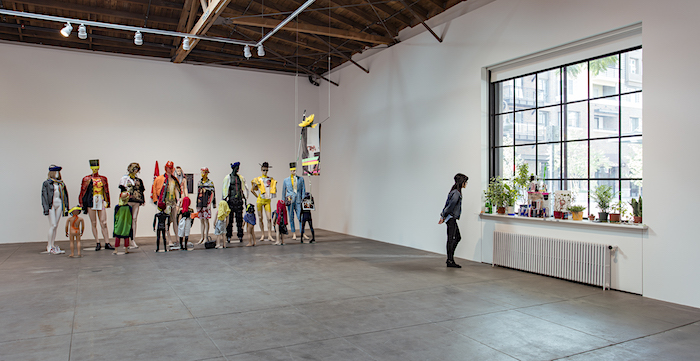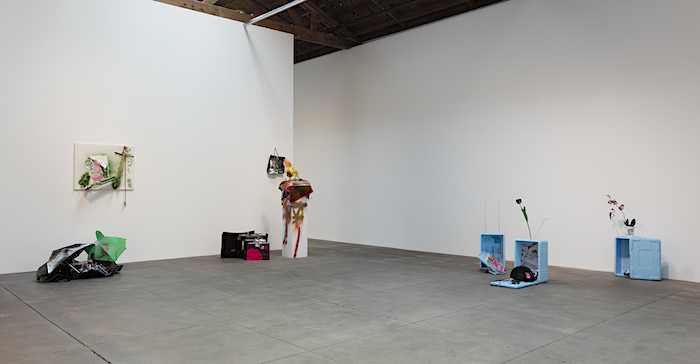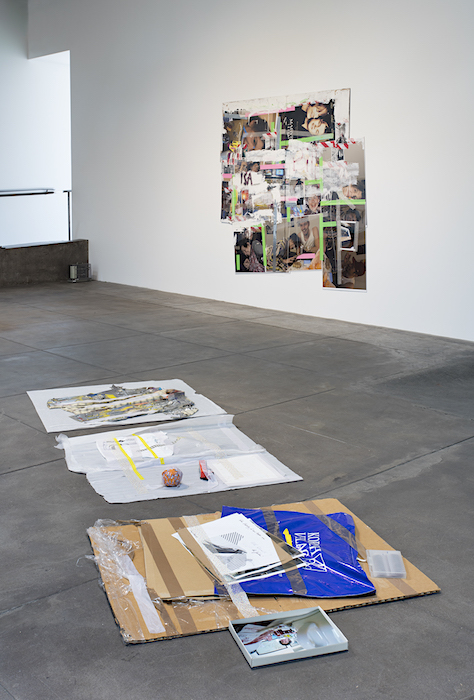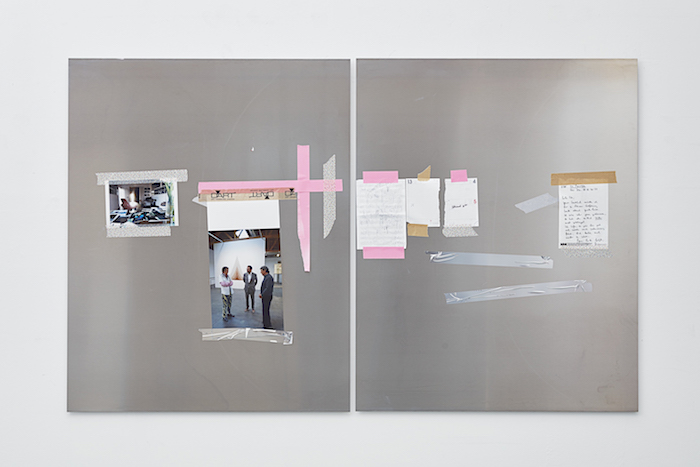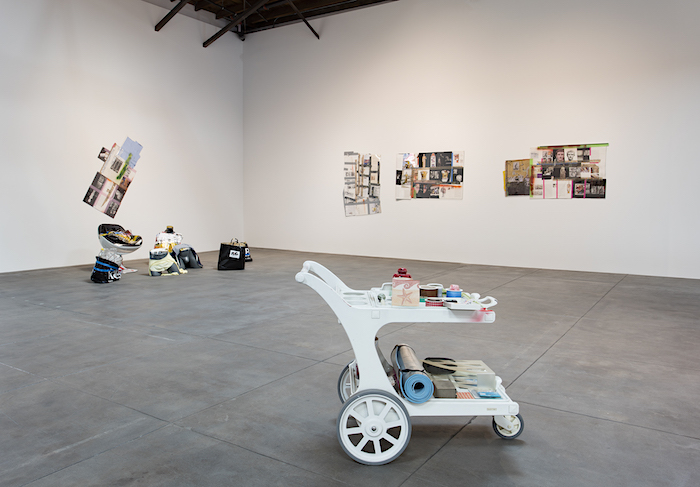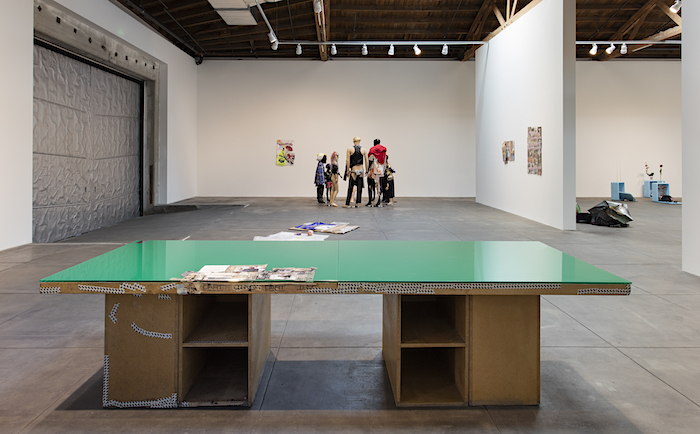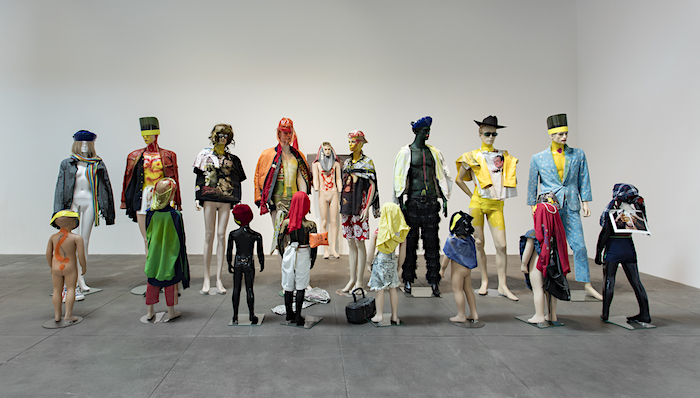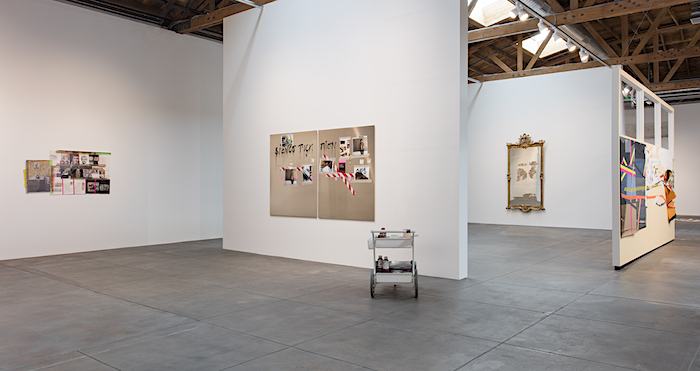October 16–December 31, 2016
In a shallow bay window facing 2nd St., a ledge overflows with studio clutter: a couple dozen euros in coins between a few dying plants; a bowl filled with loose earrings and studs; a keycard from the Waldorf Astoria; a castle of used tea candles, Red Bull cans, and tiny uniformed figurines (cops, or Luftwaffe), all iced with white paint. One only wants the empty blue ashtray to overflow with butts to complete the quintessential image of an artist at work. The setup doesn’t just mimic; nearly every object has been shipped from Genzken’s studio in Berlin, down to the ledge itself. The extant window has been remodeled and a radiator sourced to match the original. (Genzken’s actual desk is here, too. So is a reproduction of a studio wall.) Her process has seemingly been frozen, portioned into discrete pieces, and mailed to L.A.
The collages and assemblages, accordingly, are laced with the leftovers of art handling, packing and unpacking; one trio of works is laid out on their boxes; several pieces include tape marked with the D’ART® logo of a transatlantic shipping company. (All works are from 2016 and, except where noted, untitled.) Other sculptures feature German shopping bags. An English-language “Open” sign is powered via European-standard plug and adapter. “I Love Michael Asher” presents the assembled expressiveness of Genzken’s work as “imported”: insisting that all of these clothes, toys, umbrellas, styrofoam coolers, clock radios, adhesives and wires and pigments—all of this stuff—has physically crossed at least one ocean, probably two.
This much is routine for globalized economies. Meanwhile, under the flag of Hauser Wirth & Schimmel, commodities sail toward higher tiers; product leaves a workshop in Berlin for an L.A. boutique. Genzken’s intervention in said stuff serves as authentication—as if to de-abstract stuff’s spasmodic “flows.” A collage of pink and spotted adhesive tapes on two aluminum panels includes a recent photo of Genzken chatting with titular gallery partners Paul Schimmel and Iwan Wirth during the gallery’s inaugural show; behind them, on a wall now given over to Genzken, hangs an untitled work by Marisa Merz. As if more proof were needed: “Genzken was here.” Pastiched phrases like “SIENCE FICKTION” and “FUCK OUI” headline scrappy material pile-ons—glossy lines of tape or sprays of torn currency, a printout of Caravaggio’s Boy Bitten by a Lizard (1596). Art and pop and empire intertwine into a formalism of correspondence. One in a lineup of mannequins, titled Schauspieler (Actors), wears a t-shirt in memory of Michael Jackson, who died three years before Michael Asher. In the tribute to one Michael, Genzken points to the mass-market mourning for another.
“I Love Michael Asher” draws a line from Genzken to Asher, whom she apparently met just once. One chaotic, the other cerebral, both artists arguably share a postmodern self-reflexivity. There’s also a bit of tongue-in-cheek to the premise, like when Beuys says he loves America. Genzken’s work often wears the marks of its own production, but by belaboring its fidelity to the “artist’s actual studio” (where Asher was decidedly post-), the present show makes Genzken’s own physical circulation one of the more revealing institutional features. Her studio wall, faithfully reproduced and collaged with striped tape and disco-ball tile, runs parallel to the sight lines of two big mirrors in faux-gilt frames. The mirrors face each other across a gallery stall, murky and warped but regressing en abyme nonetheless. They are, we assume, Genzken’s mirrors, brought from Berlin, in which the image of the artist at work might bounce back and forth forever. In such a setting, institutional critique offers not the softening effects of introspection, nor the dialectical unwinding of advanced capitalism, but the trap of Hegel’s bad infinity: a self-satisfied oscillation.1 Where Asher might remove a wall to expose the office, Genzken adds one, rendering the artist’s chain-smoking stereotype transparent.
See Steven Shaviro, “Parasites on the Body of Capital,” No Speed Limit (Minneapolis: 2014, University of Minnesota Press), 44-45.
